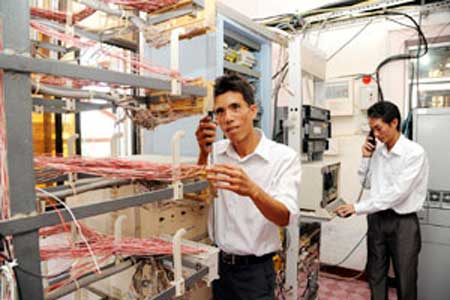VietNamNet Bridge ? Development of Viet Nam's wired and wireless broadband internet infrastructure can progress ahead of schedule, despite the country setting a target of becoming a modern industrial nation by 2020.

Technicians check circuits in Quang Ninh Province's Van Don District. Viet Nam's wired and wireless broadband internet infrastructure is expected to progress ahead of schedule.
The forecast was made by IT experts at a telecoms conference held recently to thoroughly grasp the contents of Resolution 13- NQ/TW from the Party Central Committee and plans to build information infrastructure.
Addressing the conference, Minister of Information and Communication Nguyen Bac Son said the Resolution aimed to build synchronous internet infrastructure to turn Viet Nam into a modern industrial country by 2020.
Target for broadband internet by 2015
- Fixed broadband internet: 6 to 8 subscribers / 100 people
- Wireless broadband: 20 to 25 subscribers / 100 people
- Households with internet access: 15-20 per cent
- 90 per cent of communes have public telecom services with broadband connection.
Target for broadband internet by 2020
- Fixed broadband internet: 15 to 20 subscribers / 100 people
- Wireless broadband: 35 to 40 subscribers / 100 people
- Households with internet access: 35 to 40 per cent
- 100 per cent of communes have public telecom services with broadband connection.
Son said the Resolution determined that information technology was one of the most important infrastructures, both for the economy and technical sectors as well as social development.
According to World Bank research, 10 per cent of the population using broadband internet would boost the GDP of developed countries by 1.21 per cent, and up to 1.38 per cent in developing countries.
Use of wireless broadband internet is currently thriving and has exceeded the forecast of the International Telecommunication Union (ITU).
Doan Quang Hoan, Director of the Radio Frequency Department under the Ministry of Information and Communication said wireless broadband internet would become increasingly popular as it was vital infrastructure for a knowledge-based economy.
In the near future, the number of 2G subscribers would decrease while the number of 3G subscribers would grow strongly.
Meanwhile, HSPA (High Speed Packet Access) technology remains the most promising technology prior to 2020, said Hoan.
Hoan said Viet Nam had a good quality advanced wireless broadband infrastructure. The number of 2G and 3G subscribers in the country has increased in recent years, but Viet Nam is still in the early stages of wireless broadband internet.
He said development of wireless broadband has strong potential, but currently remains limited due to consumers' purchasing power.
Le Thi Ngoc Mo, deputy director of the Radio Frequency Department said development of fixed broadband internet would be a challenge for the local telecoms industry.
Over the last two years, development of fixed broadband internet has seen slower growth. Currently, landline phone networks were considered the best platform for broadband internet development.
Viet Nam Post and Telecommunications Group (VNPT)?s service accounted for 90 per cent of the telecom market, but the service has been reduced 25 per cent annually in recent years. During its peak, VNPT had 13 million subscribers, but that figure has fallen to just 6.5 million.
With the increasing popularity of mobile phones, the number of fixed landline phone subscribers will continue to fall sharply in years to come.
Viet Nam aims for 90 per cent of communes to have access to broadband internet by 2015, with comprehensive access by 2020.
Mo said developing stable and safe broadband was the national strategy. Therefore, the Ministry would soon outline its policies on tariff and service charges for landline telephone services and on development to FTTH (Fiber-To-The-Home).
The most important thing was to use the Viet Nam Public Utility Telecommunication Service Fund as a source of finance for developing telecoms infrastructure. It was estimated that from 2013 to 2020, this fund would grow to around VND10 trillion ($480 million), said Mo.
Source: VNS
Source: http://dongtalk.com/2013/01/22/telecoms-industry-leads-development/
tenacious d steve smith zou bisou bisou tim tebow press conference tebow press conference trina rob dyrdek
No comments:
Post a Comment
Note: Only a member of this blog may post a comment.